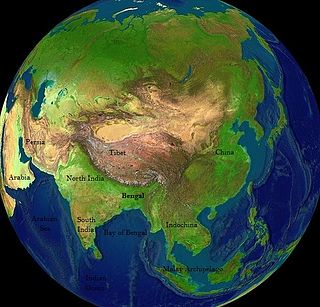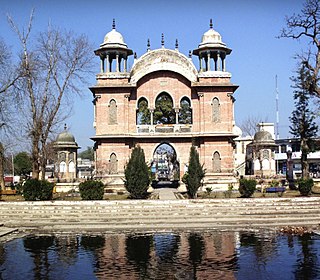
Balochistan is a province of Pakistan. Located in the southwestern region of the country, Balochistan is the largest province of Pakistan by land area but is the least populated one. It is bordered by the Pakistani provinces of Khyber Pakhtunkhwa to the north-east, Punjab to the east and Sindh to the south-east; shares international borders with Iran to the west and Afghanistan to the north; and is bound by the Arabian Sea to the south. Balochistan is an extensive plateau of rough terrain divided into basins by ranges of sufficient heights and ruggedness. It has the world's largest deep sea port, the Port of Gwadar lying in the Arabian Sea.

Bengal is a historical geographical, ethnolinguistic and cultural term referring to a region in the eastern part of the Indian subcontinent at the apex of the Bay of Bengal. The region of Bengal proper is divided between modern-day Bangladesh and the Indian state of West Bengal. The Indian states of Assam, Jharkhand and Tripura have a sizeable Bengali population. A large Bengali diaspora exists across the world. Bengali is the sixth-most spoken language in the world.

Kashmir is the northernmost geographical region of the Indian subcontinent. Until the mid-19th century, the term "Kashmir" denoted only the Kashmir Valley between the Great Himalayas and the Pir Panjal Range. Today, the term encompasses a larger area that includes the India-administered territories of Jammu and Kashmir and Ladakh, the Pakistan-administered territories of Azad Kashmir and Gilgit-Baltistan, and the Chinese-administered territories of Aksai Chin and the Trans-Karakoram Tract.

Khyber Pakhtunkhwa is a province of Pakistan. Located in the northwestern region of the country, Khyber Pakhtunkhwa is the fourth largest province of Pakistan by land area and the third-largest province by population. It is bordered by the Pakistani provinces of Balochistan to the south, Punjab to the south-east, the territory of Gilgit-Baltistan to the north and north-east, Islamabad Capital Territory to the east and Azad Kashmir to the north-east. It shares an international border with Afghanistan to the west. Khyber Pakhtunkhwa has a varied landscape ranging from rugged mountain ranges, valleys, plains surrounded by hills, undulating submontane areas and dense agricultural farms.

Pakistan, officially the Islamic Republic of Pakistan, is a country in South Asia. It is the fifth-most populous country, with a population of over 241.5 million, having the largest Muslim population as of 2023. Islamabad is the nation's capital, while Karachi is its largest city and financial centre. Pakistan is the 33rd-largest country by area, being the second largest in South Asia. Bounded by the Arabian Sea on the south, the Gulf of Oman on the southwest, and the Sir Creek on the southeast, it shares land borders with India to the east; Afghanistan to the west; Iran to the southwest; and China to the northeast. It shares a maritime border with Oman in the Gulf of Oman, and is separated from Tajikistan in the northwest by Afghanistan's narrow Wakhan Corridor.

Punjab is a geopolitical, cultural, and historical region in South Asia. It is specifically located in the northwestern part of the Indian subcontinent, comprising areas of modern-day eastern-Pakistan and northwestern-India. Punjab's major cities are Lahore, Faisalabad, Rawalpindi, Gujranwala, Multan, Ludhiana, Amritsar, Sialkot, Chandigarh, Shimla, Jalandhar, Patiala, Gurugram, and Bahawalpur.

Punjab, known historically as Panchanada and Pentapotamia, is a province of Pakistan. Located in central-eastern region of the country, Punjab is the second-largest province of Pakistan by land area and the largest by population. Lahore is the capital and the largest city of the province. Other major cities include Faisalabad, Rawalpindi, Gujranwala and Multan.

Mohenjo-daro is an archaeological site in Larkana District, Sindh, Pakistan. Built c. 2500 BCE, it was the largest settlement of the ancient Indus Valley Civilisation, and one of the world's earliest major cities, contemporaneous with the civilizations of ancient Egypt, Mesopotamia, Minoan Crete, and Norte Chico.
The Punjabis, are an Indo-Aryan ethnolinguistic group associated with the Punjab region, comprising areas of eastern Pakistan and northwestern India. They generally speak Standard Punjabi or various Punjabi dialects on both sides.

The Somanath temple or Deo Patan, is a Hindu temple located in Prabhas Patan, Veraval in Gujarat, India. It is one of the most sacred pilgrimage sites for Hindus and is the first among the twelve jyotirlinga shrines of Shiva. It is unclear when the first version of the Somnath temple was built, with estimates varying between the early centuries of the 1st millennium and about the 9th century CE. The temple is not mentioned in ancient Sanskrit texts of Hinduism as Somnath nomenclature, but the "Prabhasa-Pattana" is mentioned as a tirtha, where this temple exists. For example, the Mahabharata in Chapters 109, 118, and 119 of Book 3, and Sections 10.45 and 10.78 of the Bhagavata Purana state Prabhasa to be a tirtha on the coastline of Saurashtra.

A Short History of Pakistan is an edited book published by University of Karachi Press and comprises four volumes. The book is edited by Prof Ishtiaq Hussain Qureshi and provides a comprehensive account of the history of the Pakistan region and its people from the prehistory leading to the creation of Pakistan and East Pakistan which then became Bangladesh. Complete set of four volumes are sequentially titled as, Book One: Pre-Muslim Period by Ahmad Hasan Dani; Book Two: Muslim Rule under the Sultans by M. Kabir; Book Three: The Mughul Empire by Sh. A. Rashid; and, Book Four: Alien Rule and the Rise of Muslim Nationalism by M. A. Rahim et al.

Mardān is a city in the Mardan District of Khyber Pakhtunkhwa Province, Pakistan. Located in the Valley of Peshawar, Mardan is the second-largest city of Khyber Pakhtunkhwa. It is a fast-growing city that experienced a population boom in the latter half of the twentieth century.

The predecessors to the contemporary Army of India were many: the sepoy regiments, native cavalry, irregular horse and Indian sapper and miner companies raised by the three British presidencies. The Army of India was raised under the British Raj in the 19th century by taking the erstwhile presidency armies, merging them, and bringing them under the Crown. The British Indian Army fought in both World Wars.

Western India is a loosely defined region of India consisting of western states of Republic of India. The Ministry of Home Affairs in its Western Zonal Council Administrative division includes the states of Goa, Gujarat, and Maharashtra along with the Union territory of Dadra and Nagar Haveli and Daman and Diu, while the Ministry of Culture and some historians also include the state of Rajasthan. The Geological Survey of India includes Maharashtra but excludes Rajasthan whereas Ministry of Minority Affairs includes Karnataka but excludes Rajasthan.

The 'Bhavishya Purana' is one of the eighteen major works in the Purana genre of Hinduism, written in Sanskrit. The title Bhavishya means "future" and implies it is a work that contains prophecies regarding the future.

The History and Culture of the Indian People is a series of eleven volumes on the history of India, from prehistoric times to the establishment of the modern state in 1947. Historian Ramesh Chandra Majumdar was the general editor of the series, as well as a major contributor. The entire work took 26 years to complete. The set was published in India by the Bharatiya Vidya Bhavan, Mumbai.

The Indian subcontinent is a physiographical region in Southern Asia, mostly situated on the Indian Plate, projecting southwards into the Indian Ocean from the Himalayas. Geopolitically, it spans major landmasses from the countries of Bangladesh, Bhutan, India, Maldives, Nepal, Pakistan, and Sri Lanka. Although the terms "Indian subcontinent" and "South Asia" are often used interchangeably to denote the region, the geopolitical term of South Asia frequently includes Afghanistan, which is not considered part of the subcontinent.

South Asia is the southern subregion of Asia, which is defined in both geographical and ethnic-cultural terms. As commonly conceptualized, the modern states of South Asia include Afghanistan, Bangladesh, Bhutan, India, Maldives, Nepal, Pakistan, and Sri Lanka. South Asia borders East Asia to the northeast, Central Asia to the northwest, West Asia to the west and Southeast Asia to the east. Topographically, it is dominated by the Indian subcontinent and is bounded by the Indian Ocean in the south, and the Himalayas, Karakoram, and Pamir Mountains in the north.

Pakistanis are the citizens and nationals of the Islamic Republic of Pakistan. According to the 2017 Pakistani census, the population of Pakistan stood at over 213 million people, making it the world's fifth-most populous country. The majority of Pakistanis natively speak languages belonging to the Indo-Iranic family.

















